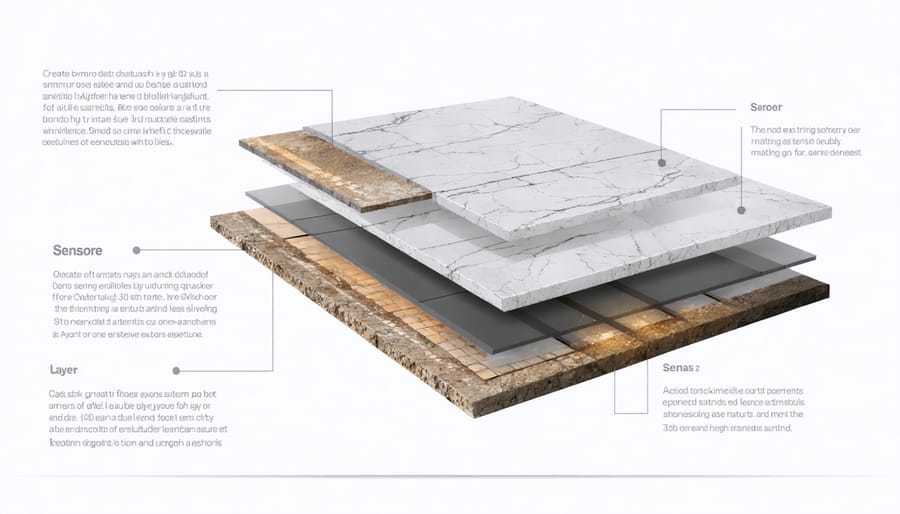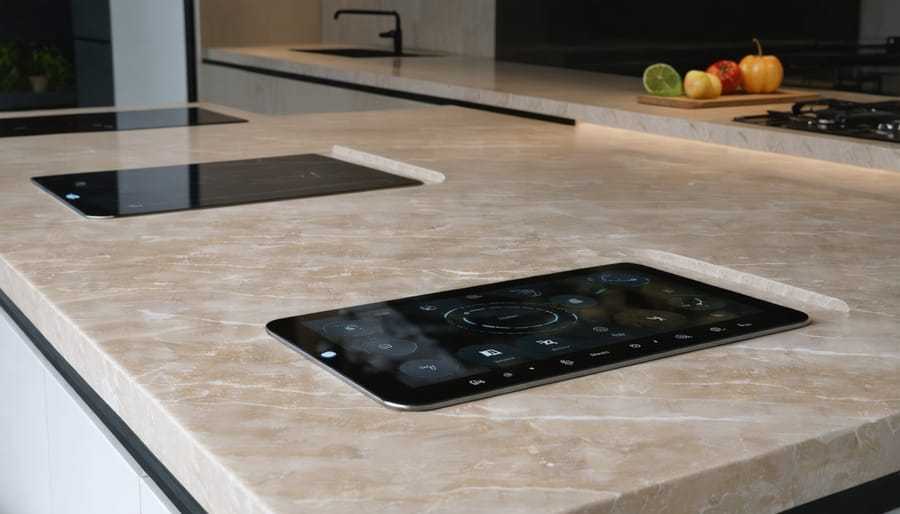Transform your living space into an intelligent ecosystem where natural stone meets modern technology through innovative smart home upgrades. Stone-systems represent the perfect fusion of timeless elegance and cutting-edge automation, allowing homeowners to control lighting, temperature, and ambiance through seamlessly integrated stone surfaces.
Natural stone, once purely decorative, now serves as an interactive interface for home automation. Imagine marble countertops with embedded touch controls, limestone walls housing advanced climate sensors, and granite surfaces incorporating LED lighting systems that respond to voice commands. These innovations not only preserve the organic beauty of natural stone but enhance its functionality for modern living.
Industry leaders are revolutionizing how we interact with our homes by embedding sophisticated technology within stone materials while maintaining their inherent durability and aesthetic appeal. This convergence of ancient material and modern innovation creates spaces that are both luxurious and intelligently responsive to our daily needs.
This evolution in stone application represents more than just technological advancement – it’s a fundamental shift in how we perceive and interact with natural materials in our living spaces.
What Are Stone-Systems in Smart Homes?
Components of Smart Stone Integration
Smart stone integration combines multiple components to create a seamless, intelligent system. At its core lies the sensor network, which includes pressure sensors, temperature monitors, and motion detectors embedded within or attached to stone surfaces. These sensors communicate with a central control unit that processes data and coordinates system responses.
The integration hub serves as the brain of the system, connecting stone elements with other smart home features. This hub typically includes wireless connectivity options like Wi-Fi, Bluetooth, or Z-Wave protocols to ensure reliable communication between components.
LED lighting systems integrated into stone features provide both functional and ambient illumination, while smart heating elements can be incorporated into stone flooring or wall panels for climate control. Touch-sensitive surfaces and gesture recognition technology transform stone surfaces into interactive interfaces.
Environmental monitoring components track humidity, temperature, and wear patterns to protect the stone’s integrity. Many systems also include mobile applications that allow users to control and monitor their smart stone features remotely, adjusting settings and receiving maintenance alerts as needed. These components work together to enhance both the functionality and longevity of natural stone installations.

Technology Behind Stone-Systems
Stone-systems represent a groundbreaking fusion of traditional natural stone and modern smart home technology. At the core of these systems are advanced sensors embedded within or beneath stone surfaces that monitor temperature, pressure, and touch. These sensors communicate with a central hub using low-energy Bluetooth or Wi-Fi protocols, enabling seamless integration with existing home automation systems.
The technology incorporates specialized moisture-resistant circuitry designed specifically for stone applications, ensuring durability and longevity. LED integration allows for subtle lighting effects, while capacitive touch sensors transform stone surfaces into interactive control panels for various home functions.
What makes these systems particularly innovative is their ability to preserve the natural beauty and texture of stone while adding smart functionality. The installation process involves precision cutting and carefully engineered mounting systems that protect both the stone and the embedded technology. Temperature regulation systems can be incorporated to maintain optimal surface conditions, while advanced waterproofing techniques ensure the electronics remain protected in wet environments like bathrooms and kitchens.
This technology enables homeowners to control lighting, temperature, and other home systems through their stone surfaces while maintaining the timeless elegance of natural stone.
Benefits of Smart Stone Integration
Energy Efficiency and Temperature Control
Stone systems play a crucial role in modern home energy management, offering natural thermal regulation capabilities that can significantly reduce heating and cooling costs. The inherent thermal mass properties of stone allow it to absorb, store, and gradually release heat, creating a more stable indoor temperature throughout the day.
When integrated with smart home technology, stone systems become even more efficient. Temperature sensors embedded within stone walls or flooring can communicate with smart thermostats, optimizing HVAC operation based on the stone’s natural heat retention patterns. This synergy between traditional materials and modern technology can reduce energy consumption by up to 25% in properly designed spaces.
The strategic placement of stone elements, such as interior walls or floor installations, can maximize passive solar heating during winter months while providing natural cooling during summer. Smart monitoring systems can track these thermal patterns and automatically adjust window shades, ventilation, and air conditioning to maintain optimal comfort levels.
Modern stone systems also incorporate advanced insulation techniques and vapor barriers, preventing unwanted heat loss or gain. When combined with smart climate control, these systems can automatically adjust to weather changes, occupancy patterns, and daily temperature fluctuations, ensuring optimal energy efficiency while maintaining comfortable living spaces.
The long-term durability of stone means these energy-saving benefits continue for decades, making it a sustainable choice for environmentally conscious homeowners.
Aesthetic and Functional Advantages
Stone-systems offer a perfect blend of timeless elegance and modern functionality, making them an increasingly popular choice for stone home improvements. The aesthetic advantages are immediately apparent in the natural beauty of stone surfaces, which create a sophisticated atmosphere while maintaining their unique character. Each installation features distinctive patterns, colors, and textures that cannot be replicated by artificial materials.
Beyond visual appeal, stone-systems deliver remarkable practical benefits. The durability of natural stone ensures long-term value, requiring minimal maintenance while withstanding daily wear and tear. These systems also contribute to improved thermal regulation, as stone naturally absorbs and releases heat gradually, helping to maintain consistent indoor temperatures.
Modern stone-systems integrate seamlessly with smart home technology, allowing for automated lighting control through stone-embedded sensors and programmable ambient settings. The non-porous nature of properly sealed stone surfaces makes them inherently hygienic and easy to clean, ideal for both residential and commercial applications.
Additionally, stone-systems enhance property value by combining traditional craftsmanship with contemporary functionality. The versatility of these systems allows for customization across various architectural styles, from minimalist modern designs to classic traditional aesthetics, ensuring they remain relevant and appealing regardless of changing design trends.
Popular Stone-System Applications

Smart Stone Flooring Systems
Smart stone flooring has evolved beyond mere aesthetics, now seamlessly integrating with home automation systems to enhance both functionality and luxury. Modern stone floors can incorporate heating elements, LED lighting, and pressure-sensitive sensors that respond to movement and touch. These intelligent systems allow homeowners to control floor temperature through smartphone apps, automatically illuminate pathways at night, and even monitor foot traffic patterns for security purposes.
Advanced pressure-mapping technology embedded beneath stone tiles can detect falls and trigger emergency alerts, making these systems particularly valuable for elderly care facilities. Some systems feature moisture detection capabilities that can warn homeowners of potential leaks before they cause damage to the stone surface.
The integration extends to energy management, where smart stone flooring systems can adjust heating patterns based on room occupancy and time of day. Programmable zoning options enable different temperature settings throughout the home, optimizing both comfort and energy efficiency. These innovations preserve the timeless beauty of natural stone while adding contemporary functionality that meets the demands of modern living.
Automated Stone Wall Features
Modern stone wall systems have evolved to incorporate smart technology, creating a seamless blend of traditional aesthetics and contemporary functionality. These automated features enhance the versatility of natural stone wall installations while maintaining their timeless appeal. Integrated LED lighting systems can be programmed to highlight the texture and depth of stone surfaces, while moisture sensors monitor and regulate wall conditions to prevent damage and extend longevity.
Smart wall systems often include temperature control elements that work with the stone’s natural thermal mass properties, helping to regulate indoor climate more efficiently. Some advanced systems incorporate touchless controls and voice-activated features that allow users to adjust lighting scenes or activate built-in water features.
Security features can be integrated directly into stone walls, with concealed cameras and sensors that maintain the wall’s aesthetic integrity while providing advanced monitoring capabilities. These systems can be controlled through smartphone apps, allowing homeowners to manage their stone wall features remotely while ensuring their investment remains protected and functional.
Kitchen and Bathroom Integration
Integrating stone systems in kitchens and bathrooms requires careful consideration of moisture resistance and functionality. Natural stone surfaces in these wet areas can be seamlessly combined with smart technology to enhance both aesthetics and practicality. Modern stone-system installations typically feature moisture-resistant sealants and specialized treatments that protect against water damage while maintaining the stone’s natural beauty.
In kitchens, stone-system integration often includes touchless faucets with stone backsplashes, automated lighting that complements stone countertops, and smart sensors for water leak detection beneath stone flooring. These systems can be programmed to monitor humidity levels and temperature changes, helping preserve the stone’s integrity over time.
Bathroom applications focus on combining luxury with practicality. Smart shower systems with stone surrounds can be programmed to maintain optimal water temperature and pressure, while heated stone flooring systems provide comfort and prevent moisture accumulation. Motion-activated lighting can be integrated with stone wall panels to create sophisticated ambient effects.
Installation considerations include proper waterproofing, adequate ventilation, and strategic placement of sensors and control panels. Modern stone systems often incorporate anti-bacterial treatments and easy-clean surfaces, making them ideal for high-moisture environments. The integration of these technologies not only enhances functionality but also helps maintain the longevity of the stone surfaces, ensuring they remain beautiful and practical for years to come.

Installation and Maintenance Considerations
Professional Installation Requirements
Professional installation of stone systems requires careful attention to both technical expertise and safety considerations. The integration of smart technology with natural stone elements demands specialized knowledge of both traditional stonework and modern automation systems.
A qualified installer should possess certifications in both stone installation and smart home technology integration. They must understand proper stone mounting techniques, load-bearing requirements, and the intricacies of embedding sensors and control systems within stone structures. This dual expertise ensures the longevity of both the stone elements and the integrated technology.
Proper installation begins with a thorough site assessment, including evaluation of electrical requirements, network connectivity, and structural support. Installers must consider factors such as moisture protection for electronic components, appropriate placement of sensors, and accessibility for future maintenance.
Key installation requirements include:
– Professional-grade mounting systems rated for stone weight
– Properly shielded electrical connections
– Waterproof housing for electronic components
– Adequate ventilation for heat-generating elements
– Secure network infrastructure
– Calibrated sensor placement
– Proper grounding and surge protection
Post-installation testing should verify both structural integrity and system functionality. Regular maintenance schedules should be established to ensure optimal performance of both stone elements and integrated technology. Homeowners should receive comprehensive training on system operation and basic troubleshooting procedures.
Long-term Maintenance Tips
To ensure your stone-system maintains its functionality and aesthetic appeal over time, implementing a comprehensive maintenance strategy is essential. Regular attention to both the technological components and natural stone elements will maximize the system’s lifespan and performance. When it comes to maintaining natural stone surfaces, establish a quarterly cleaning schedule using pH-neutral cleaners specifically formulated for stone.
For the technological components, schedule annual inspections of all sensors, actuators, and control systems. Check for loose connections, update software regularly, and replace backup batteries in smart controllers every two years. Keep detailed maintenance logs to track system performance and identify potential issues before they become problems.
Protect stone surfaces from extreme temperature fluctuations and direct sunlight, which can affect both the stone and embedded technology. Install proper ventilation systems to manage moisture levels, particularly in areas where stone and electronic components interface. Consider applying a high-quality sealer to stone surfaces every 2-3 years to prevent moisture infiltration that could damage integrated technology.
Monitor the calibration of any automated features, such as motorized stone panels or smart lighting systems. Regular system diagnostics can help identify any drift in sensor accuracy or mechanical wear. Address any unusual sounds, movements, or system responses promptly to prevent cascading issues that could affect both the technology and stone components.
As we look toward the future, stone-systems in smart homes represent a remarkable fusion of timeless natural materials with cutting-edge technology. The integration of natural stone with home automation is revolutionizing how we interact with our living spaces, offering unprecedented levels of convenience, efficiency, and aesthetic appeal.
The coming years will likely see even more innovative applications, from advanced temperature-regulating stone surfaces to interactive stone walls that respond to touch and environmental conditions. We can expect improvements in stone processing technology to make these systems more accessible and cost-effective for homeowners, while sustainability features will become increasingly prominent.
Key takeaways from our exploration of stone-systems include the importance of proper integration during the planning phase, the need for professional installation to ensure optimal performance, and the long-term value these systems add to properties. The versatility of natural stone, combined with smart technology, creates solutions that are not only beautiful but also highly functional and energy-efficient.
For homeowners and designers considering stone-systems, the investment represents a forward-thinking approach to home design that balances traditional elegance with modern convenience. As technology continues to evolve, stone-systems will undoubtedly play an increasingly significant role in creating smarter, more sustainable living spaces that honor the timeless appeal of natural stone while embracing the possibilities of the future.










